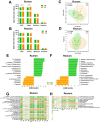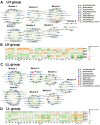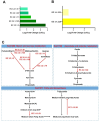Associations of rumen and rectum bacteria with the sustained productive performance of dairy cows
- PMID: 40365057
- PMCID: PMC12069273
- DOI: 10.3389/fmicb.2025.1565034
Associations of rumen and rectum bacteria with the sustained productive performance of dairy cows
Abstract
The gut bacterial community is essential for maintaining lifelong health and productivity in ruminants, but the relationship between the gut microbiota and the sustained productivity of ruminants remains inadequately understood. In this study, we selected long-lived dairy cows in mid-lactation (≥5 parities) with different levels of milk production (n = 10). Significant differences were observed in the rumen bacterial structures between the two groups of dairy cows, whereas no significant differences were detected in the rectum bacterial communities. Additionally, there were no significant differences in serum oxidative stress biomarkers, inflammatory markers, or immunological markers between the long-lived high-yield (LH) and long-lived low-yield (LL) dairy cows. Furthermore, the concentrations of propionate (Pr) in the rumen and butyrate (Bu) in the rectum were elevated in the high-yield group. Spearman correlation and microbial co-occurrence network analyses revealed that several rumen-enriched bacteria, such as Syntrophococcus, Lachnospira, Shuttleworthia, Erysipelotrichaceae_UCG-2, and Roseburiaare associated with rumen propionate (Pr) production. In the rectum, the reduced abundance of Christensenellaceae_R-7_group and Moryella favors butyrate production. Furthermore, Random Forest machine learning analysis demonstrated that six bacterial taxa in the rumen combined with one serum biomarker, as well as three bacterial taxa in the rectum combined with three serum biomarkers, can serve as potential biomarkers for distinguishing between LH and long- LL dairy cows, achieving prediction accuracies of 92 and 99%, respectively. The findings of this study indicate that rumen and rectum bacteria are associated with the milk production phenotypes of dairy cows with sustained productivity. The rumen microbes are closely linked to the long-term productive capacity of dairy cows and represent a key target for the development of gut microbiota-based interventions. The unique bacterial communities of the rumen and rectum of long-lived high-yielding dairy cows contribute to maintaining their productive capacity.
Keywords: milk yield; production performances; productive lifespan; rectum bacteria; rumen bacteria.
Copyright © 2025 Yang, Li, Sun, Zhang, Guo, Zhou, Lin, Wang and Jin.
Conflict of interest statement
The authors declare that the research was conducted in the absence of any commercial or financial relationships that could be construed as a potential conflict of interest.
Figures









Similar articles
-
Assessment of rumen bacteria in dairy cows with varied milk protein yield.J Dairy Sci. 2019 Jun;102(6):5031-5041. doi: 10.3168/jds.2018-15974. Epub 2019 Apr 10. J Dairy Sci. 2019. PMID: 30981485
-
Rumen microbes affect the somatic cell counts of dairy cows by modulating glutathione metabolism.mSystems. 2025 Apr 22;10(4):e0109324. doi: 10.1128/msystems.01093-24. Epub 2025 Mar 19. mSystems. 2025. PMID: 40105325 Free PMC article.
-
Dietary Supplementation of Inulin Ameliorates Subclinical Mastitis via Regulation of Rumen Microbial Community and Metabolites in Dairy Cows.Microbiol Spectr. 2021 Oct 31;9(2):e0010521. doi: 10.1128/Spectrum.00105-21. Epub 2021 Sep 8. Microbiol Spectr. 2021. PMID: 34494854 Free PMC article.
-
Multi-omics revealed the long-term effect of ruminal keystone bacteria and the microbial metabolome on lactation performance in adult dairy goats.Microbiome. 2023 Sep 29;11(1):215. doi: 10.1186/s40168-023-01652-5. Microbiome. 2023. PMID: 37773207 Free PMC article.
-
Rumen microbiota succession throughout the perinatal period and its association with postpartum production traits in dairy cows: A review.Anim Nutr. 2024 May 6;18:17-26. doi: 10.1016/j.aninu.2024.04.013. eCollection 2024 Sep. Anim Nutr. 2024. PMID: 39022774 Free PMC article. Review.
References
-
- Antanaitis R., Džermeikaitė K., Krištolaitytė J., Girdauskaitė A., Arlauskaitė S., Tolkačiovaitė K., et al. . (2024). The relation between milk lactose concentration and the rumination, feeding, and locomotion behavior of early-lactation dairy cows. Animals 14:836. doi: 10.3390/ani14060836, PMID: - DOI - PMC - PubMed
LinkOut - more resources
Full Text Sources
Research Materials

